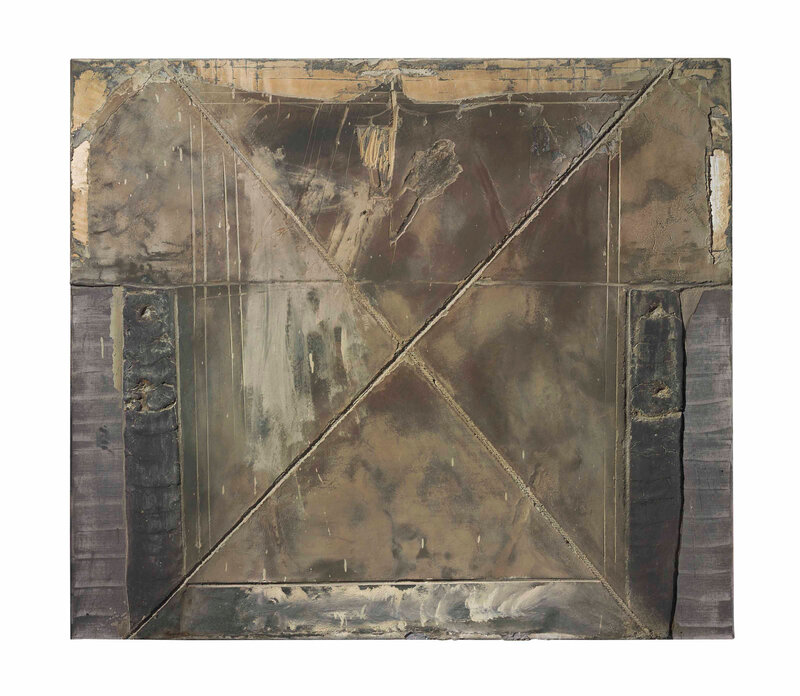Xhibition: Antoni Tàpies On view until 19 July, at Christie's London
© Christie's Image Ltd 2019
London – Christie’s Xhibition: Antoni Tàpies is now on view until 19 July 2019. Displayed in the St James’s galleries at King Street, the exhibition showcases 35 paintings and works on paper that explore the relevance and versatility of the sign `X´ - or cross in Tàpies’ work. Potent, economical and multivalent, the symbol is highly charged yet refuses rigid interpretation. Throughout his oeuvre of richly varied media, crosses are carved, painted, scrawled and collaged, constantly shifting their impact. Tàpies’ ambiguous use of the cross exploited its commonplace uses of marking locations on maps or deriving religious connotations, he even used it as the first initial of his surname.
Through his art, Tàpies evolved his own esoteric language to explore wider ideas about the relationship between matter and spirit. Developing his youthful interest in Surrealism, dreams and magic, he sought to physically incorporate mystery into his works. Despite his engagement with schools of complex existential and mystic thought, the materials he employed functioned to keep his work firmly anchored in day-to-day reality. The ‘X’, or cross married these notions within his practice, being graphically simple yet rich in allusion, it perfectly distills his ethos.
Antoni Tàpies, Gran creu negra, Executed in 1990. © Christie's Image Ltd 2019
Guillermo Cid, Specialist, Head of Post-War & Contemporary Art, Madrid, “Tàpies’ style encompasses a series of techniques and approaches that single him out as a unique voice within European abstraction of this period. He combined materialistic concerns with a symbolic cosmos inherited from the surreal art of Paul Klee and Joan Miró. The result was a radical and solemn language unlike anything else at the time. Whilst the matter is the flesh of his paintings, the crosses and the X symbols – in all their guises – are their bones and skeletons. Christie´s is thrilled to present the show as a significant part of our summer programme at King Street."
Antoni Tàpies, Gran ics gratada sobre gris, Executed in 1965. © Christie's Image Ltd 2019
Tobias Sirtl, Specialist, Post War & Contemporary Art, Munich: “Tàpies received the Rubens Prize of Siegen, West Germany, in 1972. That prize only came to confirm what had been obvious since the beginning of the ‘60s: that the well-informed European art scene of the time saw in Tàpies one of the champions of Post-War abstraction. Many of the Spanish-Catalan painter’s masterpieces are housed in major museums of central Europe and hang on the walls of the most renowned collections. We are grateful to those who have loaned us a selection of works to make this a landmark show. Tàpies’ unique pictorial idiom enriched the language of Informalism, incorporating innovative features common to contemporary movements such as Zero or Spatialism. His oeuvre is marked by a sober colour palette, the use of raw materials and the conception of his paintings as objects, rather than depictions of a reality outside the canvas. This show celebrates the pioneering language that brought Tàpies early critical acclaim in Europe and beyond."
Antoni Tàpies, Jo parlo amb la mà. Executed in 1999, Private Collection, New York. © Christie's Image Ltd 2019
Antoni Tàpies, Autoretrato. Executed in 1947, Neues Museum Nuremberg, loan from a Private Collection. © Christie's Image Ltd 2019.

/https%3A%2F%2Fprofilepics.canalblog.com%2Fprofilepics%2F1%2F0%2F100183.jpg)
/https%3A%2F%2Fstorage.canalblog.com%2F03%2F02%2F119589%2F96711876_o.jpg)
/https%3A%2F%2Fstorage.canalblog.com%2F11%2F31%2F119589%2F94773502_o.jpg)
/https%3A%2F%2Fstorage.canalblog.com%2F20%2F83%2F119589%2F94772815_o.jpg)
/https%3A%2F%2Fstorage.canalblog.com%2F26%2F72%2F119589%2F75604929_o.jpg)
/https%3A%2F%2Fstorage.canalblog.com%2F59%2F60%2F119589%2F26458628_o.jpg)







/http%3A%2F%2Fstorage.canalblog.com%2F46%2F64%2F119589%2F126860297_o.jpg)
/http%3A%2F%2Fstorage.canalblog.com%2F46%2F11%2F119589%2F125968385_o.jpg)
/http%3A%2F%2Fstorage.canalblog.com%2F93%2F41%2F119589%2F32661187_o.jpg)
/image%2F1371349%2F20240418%2Fob_ac5c4c_telechargement.jpg)